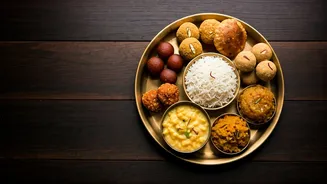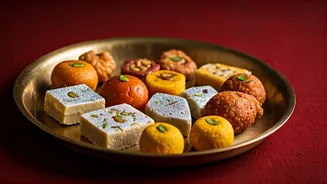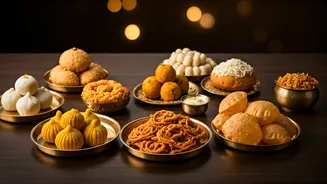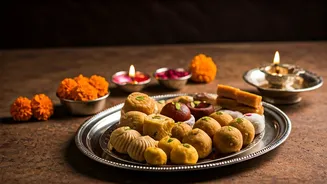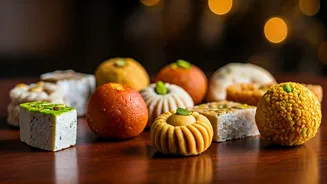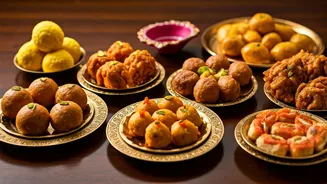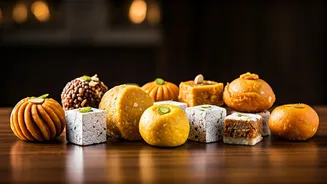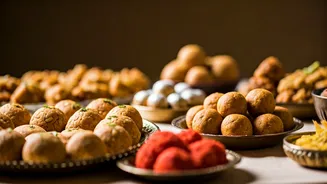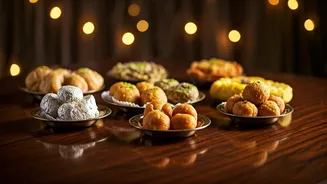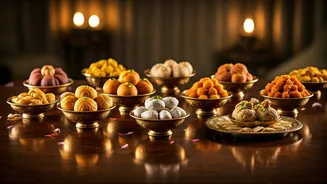Ladoo: Sweet Beginnings
Ladoo, a staple sweet, holds a special place in Diwali festivities, particularly for Lord Ganesha. These round, delightful treats are often the first offering
made during the pooja. Traditionally made with gram flour (besan), ghee, sugar, and various nuts, ladoos symbolize prosperity and good fortune. The preparation of ladoos varies across regions, with each household adding its unique touch. Their presence ensures a sweet start to any auspicious occasion, reflecting the joy and sweetness associated with the festival of lights. The act of offering ladoos is a gesture of reverence and a prayer for blessings throughout the year.
Modak: Ganesha's Delight
Modak is intrinsically linked to Lord Ganesha, often considered his favorite sweet. These dumplings, typically made from rice flour or wheat flour, are filled with a sweet mixture of coconut and jaggery. The shape of a modak is believed to resemble the divine intellect of Ganesha, and offering them is a symbol of devotion. Preparing modaks can be an elaborate process, involving carefully shaping the dough and ensuring the filling is perfectly balanced. This tradition emphasizes the importance of offering what is loved by the deity, fostering a closer spiritual connection during Diwali. The consumption of modaks brings a sense of fulfillment and is believed to bring good luck.
Kheer: A Creamy Offering
Kheer, a creamy rice pudding, is another important offering. Prepared with milk, rice, sugar, and flavored with cardamom and nuts, it offers a soothing taste and symbolizes purity and abundance. This dish represents the abundance of resources and is offered to both Lakshmi and Ganesha. Different regions have unique variations of kheer, with some incorporating ingredients like vermicelli (sewaiyan) or fruits. The preparation of kheer brings families together, sharing the task and creating a sense of unity. Its creamy texture and sweet taste make it a comforting treat and a vital part of the celebratory spread, fostering a sense of harmony.
Puri-Bhaji: A Complete Meal
Puri-bhaji, a classic combination, is a complete meal often offered during Diwali. Puri are deep-fried, puffed-up bread, and bhaji is a flavorful vegetable preparation. The bhaji is typically made with potatoes (aloo) or other seasonal vegetables, cooked with spices. This combination represents the nourishment and fulfillment needed to sustain life, offered to both deities. The act of sharing this meal highlights the significance of communal meals and shared blessings. This hearty combination embodies the spirit of Diwali, with the golden-brown puris symbolizing prosperity and the flavorful bhaji adding substance and taste to the celebration.
Halwa: Sweet Simplicity
Halwa, a sweet pudding, is a common offering, with variations depending on the region. Made from semolina (sooji), wheat flour (atta), or carrots (gajar), halwa is a symbol of joy and success. The cooking process often involves slowly roasting the base ingredient with ghee, sugar, and water, infusing the house with sweet aromas. Offering halwa reflects the desire for sweetness and positive outcomes in life, mirroring the radiant lights of Diwali. Adding nuts and spices enhances the flavors and texture, making the offering even more appealing and auspicious for the deities.
Pedas: Milk-Based Goodness
Peda, a milk-based sweet, is a popular offering for Lakshmi and Ganesha. Made with milk solids (khoya), sugar, and flavored with cardamom and saffron, pedas are a rich and delightful treat. The making of pedas is a labor of love, requiring patience and attention to detail. Their sweet and milky taste is believed to please the deities. Offering pedas symbolizes devotion and the desire for prosperity, as the rich ingredients signify abundance. They come in various shapes and sizes, often decorated with nuts or silver leaf, adding to their festive appeal and ritual significance.
Malpua: Pancake Perfection
Malpua, a sweet pancake, is a traditional offering prepared during Diwali. These thick, fluffy pancakes are deep-fried and often soaked in sugar syrup, offering a delicious taste and symbol of sweetness. The process of preparing malpuas, from mixing the batter to frying them to perfection, requires skill. Serving malpuas during Diwali represents the desire for a sweet life. They are commonly garnished with nuts and saffron, making them visually appealing and adding layers of flavor. Malpua highlight the importance of sharing delectable treats and celebrating the festival with deliciousness.
Coconut Rice: Aromatic Offering
Coconut rice, a fragrant and flavorful dish, is offered to Goddess Lakshmi. Prepared with rice cooked in coconut milk, it represents purity and abundance. The preparation involves simmering the rice with coconut milk and spices until it’s perfectly cooked. The dish symbolizes the wish for a blessed and prosperous life. The creamy texture and aromatic flavor of coconut rice make it a treat for the deities. It enhances the sense of festivity and contributes to the ritualistic significance of Diwali, filling homes with pleasant aromas and a feeling of spiritual fulfillment.
Poha: Simple yet Sacred
Poha, a quick and simple dish made from flattened rice, is often offered to Goddess Lakshmi and Lord Ganesha. It can be prepared in various ways, with the common elements being flattened rice, onions, potatoes, spices, and often peanuts. Poha is easy to make and is a representation of the practical and everyday aspects of life. Offering this dish showcases the importance of simplicity and resourcefulness. The dish's availability in many homes further signifies the universality of Diwali celebrations. This dish is a reminder that even the most straightforward offerings can have a spiritual significance.
